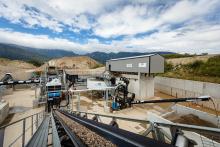
Analysts are forecasting a compound annual growth rate in the quartz market of over 4.5% in the next five years, driven by the increasing demand from the electronics industry. This is mainly due to the more widespread use of electronic devices in developing countries, including China, India, Thailand and Vietnam.
Quartz is one of the most common minerals, found in all forms of rock, but it does not exist in high purity in nature. The challenge for mining operations serving the metallurgical and engineered stone industries is to deliver quartz of consistently high chemical purity reliably – and for engineered stone manufacturers, a white product with no impurities of the same colour, such as feldspar, is also essential.
TOMRA's patented multi-channel Laser sorting technology is designed to enable a structural approach to sorting quartz. The Norway-based company says scattering effect of the multiple laser beams can be used to separate a quartz rock from a similar-looking one containing no quartz: quartz or quartz veins will appear as a glowing crystal because quartz returns the laser light in a larger area, while others will remain dark with no visible scattering.
Large and pure crystals can be clearly discriminated from other rocks or minerals with a smaller crystal structure, regardless of the colour or chemical composition.

TOMRA says its Laser sorter stands out for being a gravity system rather than the conventional conveyor belt so that both sides of the material are scanned, and multiple characteristics such as surface structure, size, shape, brightness and colour distribution are processed simultaneously. It adds that laboratory tests and field experience have shown that the recovery of valuable rocks can be increased by 20% while improving the quality of the product.
Jens-Michael Bergmann, industrial mineral segment manager at TOMRA Sorting Mining, commented: "The advantages for mine operations are multiple, from a long life for the mine to lower operating costs and a reduction of waste, with consequent lower haulage costs. It also enables them to guarantee consistent high quality of product to their customers."
Spanish company Erimsa, part of silicon-based materials supplier Elkem AS, is using TOMRA's sorting technology. Erimsa specialises in the production of aggregates for the construction industry and metallurgical quartz, which means that a consistently high chemical purity of the quartz is paramount.
In 2000, the company introduced Color sorting technology. However, to achieve a high level of purity they required, the sorters were calibrated in a way that resulted in high rejection rates of material containing quartz.
Therefore, Erimsa started operating a PRO Secondary LASER Dual sorting machine at its Salamanca processing plant in 2016. The quartz is extracted and washed to avoid dust in the plant. Then it is screened by size. Materials over 70mm are hand-picked by four operators; materials under 20mm are shipped to aggregates and quartz sand customers; materials between 20 and 70mm are fed to the TOMRA multi-channel Laser machine, which sorts out the waste material.
A final quality check is conducted by two operators to remove the rare pieces with quartz content that may have been ejected in the waste by the sorter, as it is calibrated to maximise recovery.
Carlos Forján, quality manager at Erimsa, commented: "The TOMRA machine has enabled us to reduce costs while increasing our yield; our production has easily increased by 20% compared to when we used Color sorters combined with hand picking. Material that in the past was lost to the waste pile is now generating profit for us. The stability of the quality is an important goal, and we have achieved this with the Laser sorter. It has been such a game-changer in our operation, that we are planning the purchase of a second Laser machine to replace an existing Color sorter."









